List of amphibians of Poland
Poland is inhabited by 18 amphibian species. They include five species of newts and salamanders from a single family, Salamandridae, as well as 13 frog and toad species from five families—Bombinatoridae, Bufonidae, Hylidae, Pelobatidae and Ranidae. All of them are protected by law.[1]
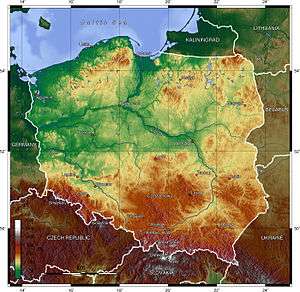
List of species
Order Caudata
Family Salamandridae
Salamandridae, or true salamanders, are a family of terrestrial and aquatic salamanders, mostly distributed in Asia and Europe, although some species are found in North Africa and North America. Most species have slightly toxic skin secretions and many develop dorsal body and tail fins when they return to an aquatic stage. There are 109 species in 21 genera; of them, five species in four genera are found in Poland.[2]
| Species | Common name | Distribution | Status[a] | Image |
|---|---|---|---|---|
| Lissotriton montandoni | Carpathian newt | Occurs in the southern areas of the Subcarpathian, Silesian, and Lesser Poland voivodeships[3] | 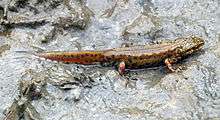 | |
| Lissotriton vulgaris | smooth newt | Found in the whole country, most commonly in the lowlands, usually up to 1500 m altitude[5] (1087 m in the Tatra Mountains, and 1250 m in the Karkonosze)[6] |  | |
| Mesotriton alpestris | Alpine newt | Occurs in the Sudetes, the Carpathians, and the Świętokrzyskie Mountains, up to 1700 m altitude; in the Polish regions of the Tatra Mountains, it can be found at up to 1665 m altitude, in the Small Polish Pond of the Valley of the Five Polish Ponds; it's also fairly common in the Smreczyński Pond and the Gąsienicowa Valley[8] | 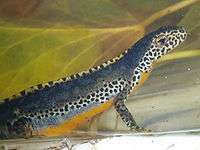 | |
| Salamandra salamandra | fire salamander | Occurs at altitudes of 250 m to 1087 m in the Carpathian and the Sudety mountains,[10] and up to 1000 m, rarely 1300 m, in the Tatra Mountains[11] |  | |
| Triturus cristatus | northern crested newt | Found in the whole country,[13] usually up to 300 m altitude, except the highest regions of the Tatra and the Sudety mountains[14] |  | |
Order Anura
Family Bombinatoridae
Bombinatoridae are an Old World toad family often referred to as fire-bellied toads because of their brightly coloured ventral sides which demonstrate their high toxicity. It includes ten species in two genera, Barbourula and Bombina, both of which have flattened bodies, of which two species from genus Bombina occur in Poland.[16]
| Species | Common name | Distribution | Status | Image |
|---|---|---|---|---|
| Bombina bombina | European fire-bellied toad | Occurs in the lowlands of the country, but not en masse; up to 400 m attitude[8] | _tight_crop.jpg) | |
| Bombina variegata | yellow-bellied toad | Occurs primarily in the Carpathian Mountains[18] and on their foothils, as well as in isolated localities in the Kraków-Częstochowa Upland;[19] according to other sources, it can also be found on the eastern foothils of the Sudetes and on the Krakowsko-Chrzanowski ridge[20] |  | |
Family Bufonidae
Bufonidae are a family of toads native to every continent except Australia and Antarctica. Bufonidae include the typical toads with shortened forelimbs, hindlimbs used for walking or hopping, dry warty skin, and parotoid glands behind eyes. The family contains 590 species in 50 genera, of which 3 species from genus Bufo are found in Poland.[22]
| Species | Common name | Distribution | Status | Image |
|---|---|---|---|---|
| Bufo bufo | common toad | Found in the whole country[23] | 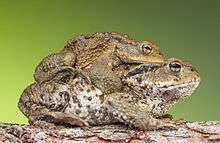 | |
| Bufo viridis | European green toad | Found in the whole country, except the southernmost regions[24] (according to some sources, it occurs rarely, if at all, in the Tatra Mountains,[25] up to 1000 m attitude;[26] it's commonly found on the southern slopes of the Pieniny mountains[25]) |  | |
| Bufo calamita | natterjack toad | Found in the whole country, except the Carpathian Mountains[27] |  | |
Family Hylidae
Hylidae or tree frogs are the most diverse amphibian family with 951 species in 51 genera, and worldwide distribution. Most species inhabit tropical areas with warm and humid climate, especially the Neotropics. Hylids range from small to large in size and usually have distinct adhesive toe discs that contain a cartilage offsetting the terminal phalanx, which aids in climbing. The only genus found in Europe is Hyla, with 6 species out of 37 worldwide, and one in Poland.[28]
| Species | Common name | Distribution | Status | Image |
|---|---|---|---|---|
| Hyla arborea | European tree frog | Common in the whole country[29] |  | |
Family Pelobatidae
Pelobatidae, also known as spadefoot toads, are a small family of frogs with one genus and four species spread in Europe, Western Asia and North-western Africa. They have short legs, stocky bodies with vertical pupils and produce an odour similar to garlic. One of the four species inhabits the country.[31]
| Species | Common name | Distribution | Status | Image |
|---|---|---|---|---|
| Pelobates fuscus | common spadefoot | Occurs in the lowlands of the country, but not en masse; absent in the mountains[8] |  | |
Family Ranidae
Ranidae are a widespread family also known as true frogs. They have generalized frog body plans and a generalized aquatic tadpole stage. The family includes 379 species in 14 genera, of which six species in two genera occur in Poland.[31]
| Species | Common name | Distribution | Status | Image |
|---|---|---|---|---|
| Pelophylax kl. esculentus | edible frog | Occurs in the lowlands of the country, up to 800 m attitude[33][34] |  | |
| Pelophylax lessonae | pool frog | Found in the whole country, up to 800 m altitude[36][37] | ||
| Pelophylax ridibundus | marsh frog | Although rare, it can be found in the lowlands of the country[8] |  | |
| Rana dalmatina | agile frog | Occurs in southeastern Poland, mainly in the southern regions of the Sandomierz Basin and on the adjacent Carpathian Foothills[39] | 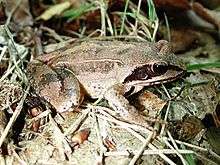 | |
| Rana temporaria | common frog | Found in the whole country[41] | .jpg) | |
| Rana arvalis | moor frog | Common species in the lowlands of the country[8] | 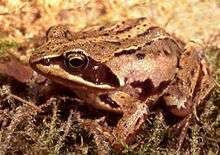 | |
See also
Footnotes
Notes
^ a: Conservation status at a world level (not exclusive to Poland) of the species according to the IUCN Red List: Conservation status - IUCN Red List of Threatened Species:
- EX - Extinct, EW - Extinct in the wild
- CR - Critically endangered, EN - Endangered, VU - Vulnerable
- NT - Near threatened, LC - Least concern
- DD - Data deficient, NE - Not evaluated
Citations
- Rozporządzenie Ministra Środowiska z dnia 12 października 2011 r. w sprawie ochrony gatunkowej zwierząt Dz. U. z 2011 r. Nr 237, poz. 1419 (in Polish)
- "Salamandridae". AmphibiaWeb. Retrieved March 25, 2016.
- Babik, Wiesław. "Triturus montandoni (Boulenger, 1880)". Podręcznik metodyczny. T. 6: Gatunki zwierząt z wyjątkiem ptaków (in Polish). Natura2000. pp. 294–297.
- Arntzen, J.W.; et al. (2009). "Lissotriton montandoni". IUCN Red List of Threatened Species. 2009. Retrieved March 25, 2016.CS1 maint: ref=harv (link)
- Gruber, Ulrich (1997). Płazy i gady, gatunki środkowoeuropejskie. Świat przyrody (in Polish). Warszawa: Multico. p. 14. ISBN 8370731147.
- Gruber, Ulrich (1997). Płazy i gady, gatunki środkowoeuropejskie. Świat przyrody (in Polish). Warszawa: Multico. p. 22. ISBN 8370731147.
- Arntzen, J.W.; et al. (2009). "Lissotriton vulgaris". IUCN Red List of Threatened Species. 2009. Retrieved March 25, 2016.CS1 maint: ref=harv (link)
- Juszczyk, Włodzimierz (1974). Płazy i gady krajowe (in Polish). Warszawa: PWN.
- Arntzen, J.W.; et al. (2009). "Mesotriton alpestris". IUCN Red List of Threatened Species. 2009. Retrieved March 25, 2016.CS1 maint: ref=harv (link)
- "Salamandra plamista" (in Polish). WIEM, darmowa encyklopedia. Retrieved March 25, 2016.
- "Salamandra plamista" (in Polish). Poznaj Tatry. Retrieved March 25, 2016.
- Arntzen, J.W.; et al. (2009). "Salamandra salamandra". IUCN Red List of Threatened Species. 2009. Retrieved March 25, 2016.CS1 maint: ref=harv (link)
- Głowaciński Z.; Rafiński J. (red) (2003). "Traszka grzebieniasta Triturus cristatus (Laurenti, 1768)". In Rafiński Jan; Babik Wiesław (eds.). Atlas płazów i gadów Polski. Status-rozmieszczenie-ochrona (in Polish). Warszawa: GIOŚ. pp. 30–32. ISBN 83-7217-208-0.
- Pabijan, Maciej. "1166 Traszka grzebieniasta Triturus cristatus (Laurenti, 1768)" (PDF) (in Polish). GIOŚ. Retrieved March 25, 2016.
- Arntzen, J.W.; et al. (2009). "Triturus cristatus". IUCN Red List of Threatened Species. 2009. Retrieved March 25, 2016.CS1 maint: ref=harv (link)
- "Bombinatoridae". AmphibiaWeb. Retrieved March 25, 2016.
- Arntzen, J.W.; et al. (2009). "Bombina bombina". IUCN Red List of Threatened Species. 2009. Retrieved March 25, 2016.CS1 maint: ref=harv (link)
- Stichmann, Wilfried; Kretzschmar, Erich (1998). "Płazy". In Stichmann, Wilfried (ed.). Zwierzęta. Spotkania z przyrodą (in Polish). Warszawa: MULTICO Oficyna Wydawnicza. p. 186. ISBN 8370731856.
- Młynarski, Marian (1966). Płazy i gady Polski (in Polish). Warszawa: Państwowe Zakłady Wydawnictw Szkolnych. pp. 30–31.
- Diesener, Günter; Reichholf, Josef (1997). Płazy i Gady. Leksykon Przyrodniczy (in Polish). Warszawa: Świat Książki. pp. 50–53. ISBN 83-7129-440-9.
- Arntzen, J.W.; et al. (2009). "Bombina variegata". IUCN Red List of Threatened Species. 2009. Retrieved March 25, 2016.CS1 maint: ref=harv (link)
- "Bufonidae". AmphibiaWeb. Retrieved March 25, 2016.
- Arntzen, J.W.; et al. (2009). "Bufo bufo". IUCN Red List of Threatened Species. 2009. Retrieved March 25, 2016.CS1 maint: ref=harv (link)
- Arntzen, J.W.; et al. (2009). "Bufo viridis". IUCN Red List of Threatened Species. 2009. Retrieved March 25, 2016.CS1 maint: ref=harv (link)
- Młynarski, Marian (1966). Płazy i Gady Polski. Atlas (in Polish). Warszawa: Państwowe Zakłady Wydawnictw Szkolnych. p. 36.
- Majtyka, Tomasz. "Herpetofauna Polski i innych krajow" (in Polish). Retrieved March 23, 2016.
- Pedro Beja; et al. (2009). "Epidalea calamita". IUCN Red List of Threatened Species. 2009. Retrieved March 25, 2016.CS1 maint: ref=harv (link)
- "Hylidae". AmphibiaWeb. Retrieved March 25, 2016.
- Młynarski, Marian (1966). Płazy i gady Polski (in Polish). Warszawa: Państwowe Zakłady Wydawnictw Szkolnych. pp. 40–41.
- Arntzen, J.W.; et al. (2009). "Hyla arborea". IUCN Red List of Threatened Species. 2009. Retrieved March 25, 2016.CS1 maint: ref=harv (link)
- "Pelobatidae". AmphibiaWeb. Retrieved March 25, 2016.
- Arntzen, J.W.; et al. (2009). "Pelobates fuscus". IUCN Red List of Threatened Species. 2009. Retrieved March 25, 2016.CS1 maint: ref=harv (link)
- Berger, Leszek (2000). Płazy i gady Polski. Klucz do oznaczania (1st ed.). Warszawa-Poznań: Państwowe Wydawnictwo Naukowe. ISBN 83-01-13139-X.
- Młynarski, Włodzimierz; Siwek, Władysław (1987). Płazy i gady Polski. Atlas (in Polish) (4th ed.). Warszawa: Wydawnictwo Szkolne i Pedagogiczne. ISBN 83-02-03153-4.
- Arntzen, J.W.; et al. (2009). "Pelophylax kl. esculentus". IUCN Red List of Threatened Species. 2009. Retrieved March 25, 2016.CS1 maint: ref=harv (link)
- Arntzen, J.W.; et al. (2009). "Pelophylax lessonae". IUCN Red List of Threatened Species. 2009. Retrieved March 25, 2016.CS1 maint: ref=harv (link)
- Diesener, Günter; Reichholf, Josef (1997). Płazy i Gady. Leksykon Przyrodniczy (in Polish). Warszawa: Świat Książki. pp. 92–93. ISBN 83-7129-440-9.
- Arntzen, J.W.; et al. (2009). "Pelophylax ridibundus". IUCN Red List of Threatened Species. 2009. Retrieved March 25, 2016.CS1 maint: ref=harv (link)
- Maciej Bonk; Stanisław Bury; Sebastian Hofman; Jacek M. Szymura; Maciej Pabijan (2012). "A reassessment of the northeastern distribution of Rana dalmatina (Bonaparte, 1840)" (PDF). Herpetology Notes. 5: 345–354.
- Arntzen, J.W.; et al. (2009). "Rana dalmatina". IUCN Red List of Threatened Species. 2009. Retrieved March 25, 2016.CS1 maint: ref=harv (link)
- Arntzen, J.W.; et al. (2009). "Rana temporaria". IUCN Red List of Threatened Species. 2009. Retrieved March 25, 2016.CS1 maint: ref=harv (link)
- Sergius Kuzmin; et al. (2009). "Rana arvalis". IUCN Red List of Threatened Species. 2009. Retrieved March 25, 2016.CS1 maint: ref=harv (link)
External links
- Mazzei, P. "Amphibians and reptiles of Europe". Retrieved March 25, 2016.
- "AmphibiaWeb". Retrieved March 25, 2016.
- "The IUNC List of Threatened Species". Retrieved March 25, 2016.